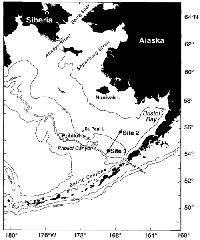
Features of the physical environment of the eastern Bering Sea (Fig. 1) — including length of day, net short-wave radiation flux (Overland et al., 2001), wind fields, ice cover, on/off shelf transport, water column structure and temperature — change with rhythms spanning a broad frequency spectrum. As a high-latitude sea, most of the physical features exhibit a strong seasonal signal as well as longer-period fluctuations ranging from year-to-year, to decadal, to trends forced by climate change (Schumacher and Alexander, 1999). Such changes in climate are mechanistically transmitted through the ocean to biota (e.g. Francis et al., 1998). Over the south-eastern shelf, the year-to-year variation in ice extent, which has ramifications for oceanic characteristics and biota, provides a mechanism not present in more temperate ecosystems. The extent and timing of sea ice cover can dramatically alter the time/space characteristics of primary/secondary production (Niebauer et al., 1995, 1990; Niebauer and Day, 1989; Stabeno et al., 1999), and hence food for larval fishes (Napp et al., 2000). Fish distributions (Wyllie-Echeverria and Wooster, 1998) and survival of age-1 pollock (Ohtani and Azumaya, 1995) respond to the extent of the cold pool of bottom water over the shelf, which is closely related to the maximum extent of ice cover. A massive increase in jellyfish population over the eastern shelf has been linked to climate change through the atmosphere's influence on ice cover (Brodeur et al., 1999).
Figure 1. Geography and place names in the eastern Bering Sea. The location of the two mooring sites is indicated by bold numerals. The hydrographic transect is shown as a solid line. Depth contours are in metres.
Understanding the south-eastern Bering Sea is of particular importance because it is the most productive marine ecosystem in the United States and one of the most productive in the world. Besides the lucrative king crab, halibut, and salmon fisheries, most of the world's catch of walleye pollock comes from the Bering Sea. Historically, marked changes in the ecosystem have occurred that resulted in changes in nodal species (e.g. National Research Council, 1996). Any change to this rich ecosystem that causes a reduction in productivity, change in species composition, or change in the portion of the food web that is usable by mankind, will have a severe societal impact. Fluctuations in the physical environment can adversely affect the ecosystem both through changes in the nutrient-phytoplankton-zooplankton sequence (bottom-up control), and by altering habitat, which results in changes in abundance and composition of higher-trophic-level animals (top-down control). Interannual variability in the atmosphere and in the ocean's response have significant implications for the biota, as shown for the North Pacific by Mantua et al. (1997). For the eastern Bering Sea, top-down control may be responsible for year-to-year fluctuation of zooplankton and phytoplankton biomasses, while bottom-up control has been suggested as the mechanism for longer period (decadal) variations (Sugimoto and Tadokoro, 1997). To advance our understanding of how the Bering Sea ecosystem functions requires monitoring the environment, identifying the important fluctuations, and elucidating the mechanisms by which changes in physical phenomenon are transferred to biota.
The Bering Sea experienced a variety of anomalous conditions during 1997 and 1998 (Stabeno, 1998; Vance et al., 1998; Napp and Hunt, 2001), including: major coccolithophorid blooms (1997 and 1998), a large die-off of shearwaters (1997; Baduini et al., 2001), salmon returns far below predicted numbers (1997 and 1998), the presence of whales in the waters of the middle shelf (1997 and 1998), unusually warm sea surface temperatures (1997 and 1998), and a decrease in the onshore transport of slope water (1997). The causal mechanisms for these events are not completely understood, but major shifts in the ecosystem have occurred in the past, and we may now be witnessing such an event.
To place the changes observed in 1997 and 1998 in context with past variability of this ecosystem, a careful examination of historical data is necessary to establish baseline characteristics of the physical environment. In the first section of this paper we discuss the factors controlling the atmospheric forcing and how 1997 and 1998 fit into the historical record. We then examine the spatial patterns and temporal variability of sea ice over the Bering Sea shelf. Next we address the variability in the currents, temperature and salinity at two sites on the Bering Sea shelf where long-term moorings have been maintained (1995-1998). Hydrographic data collected since 1966 along a transect and at the mooring sites are analysed and interpreted with focus on the conditions in 1997 and 1998. We conclude by discussing the implications that the observed changes may have on this ecosystem in the future.
Return to Abstract or go to the next section